Competitive Strategy: SWOT, Porter's Five Forces and PESTLE Analysis
VerifiedAdded on 2023/06/13
|7
|1920
|154
AI Summary
This essay evaluates the role of strategy development tools such as SWOT, Porter's Five Forces and PESTLE analysis in generating competitive advantage. It provides examples from pharmaceuticals, tourism and agriculture industries, focusing on Wesfarmers Limited, Qantas Airways, and Australian Pharmaceuticals Industries. The essay discusses the strengths, weaknesses, opportunities, and threats of these companies and evaluates the external and internal factors that affect their business. Effective use of these tools assists companies in understanding current and future factors that affect their business and enable them to create strategic policies for sustaining their future growth.
Contribute Materials
Your contribution can guide someone’s learning journey. Share your
documents today.
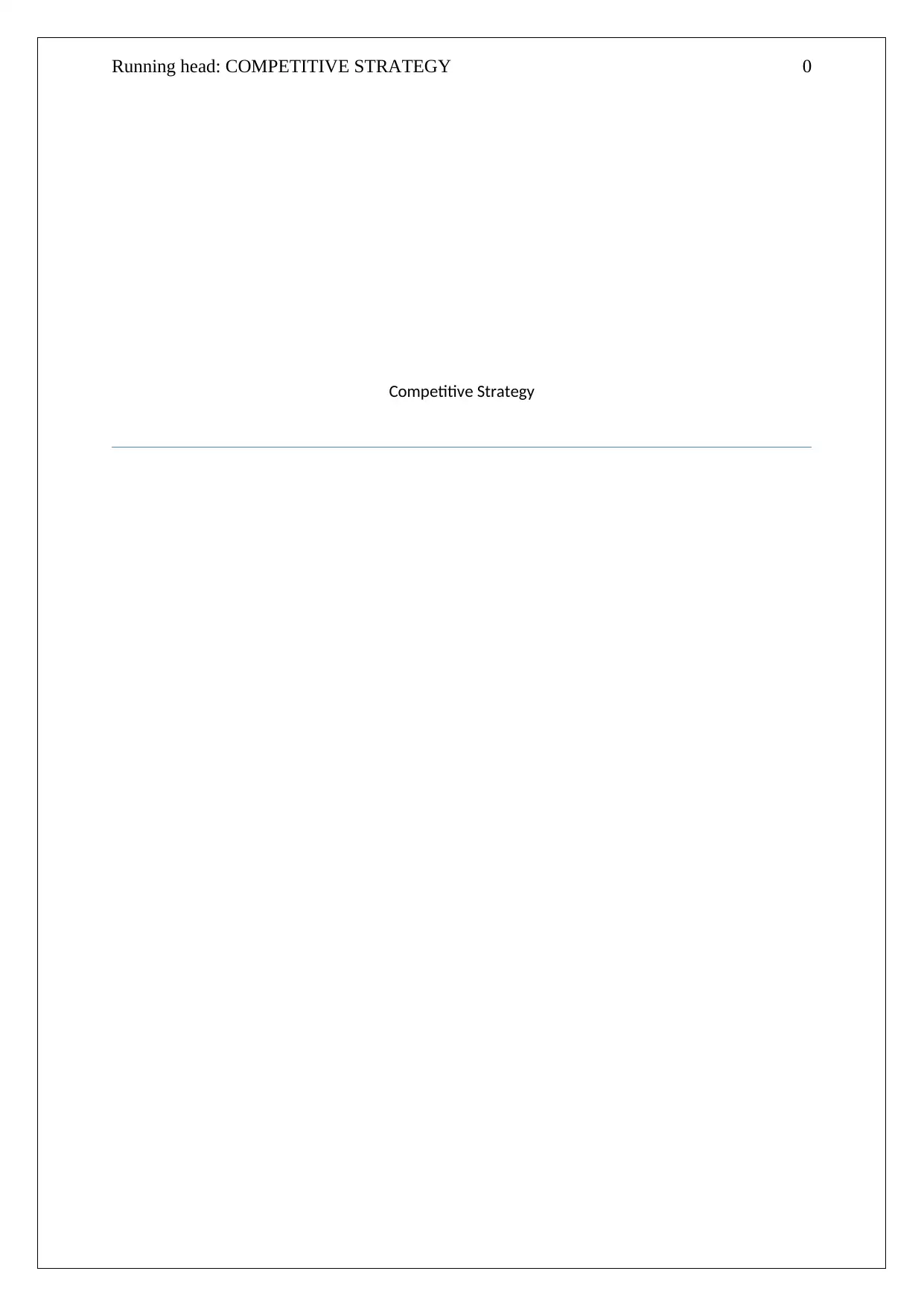
Running head: COMPETITIVE STRATEGY 0
Competitive Strategy
Competitive Strategy
Secure Best Marks with AI Grader
Need help grading? Try our AI Grader for instant feedback on your assignments.
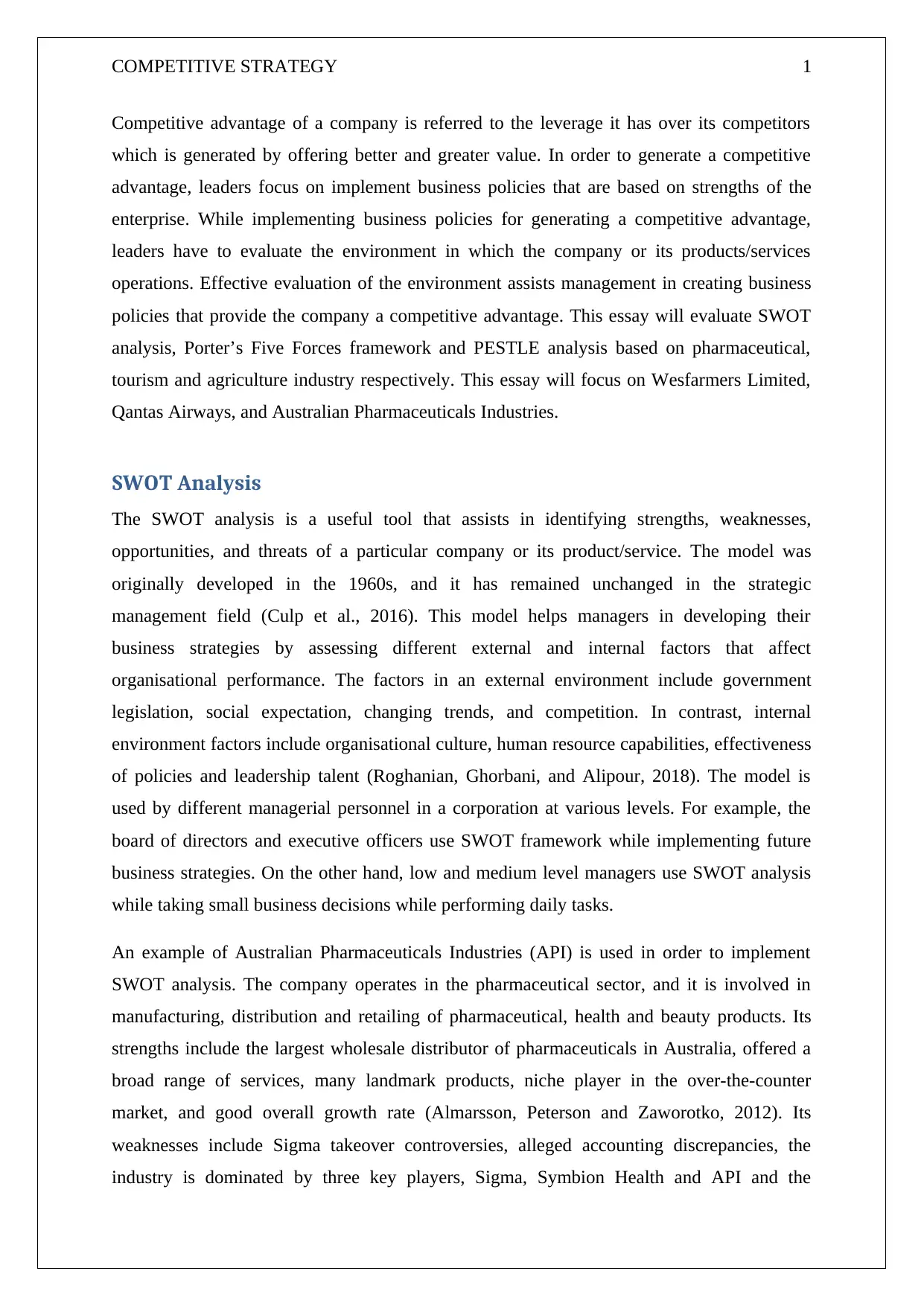
COMPETITIVE STRATEGY 1
Competitive advantage of a company is referred to the leverage it has over its competitors
which is generated by offering better and greater value. In order to generate a competitive
advantage, leaders focus on implement business policies that are based on strengths of the
enterprise. While implementing business policies for generating a competitive advantage,
leaders have to evaluate the environment in which the company or its products/services
operations. Effective evaluation of the environment assists management in creating business
policies that provide the company a competitive advantage. This essay will evaluate SWOT
analysis, Porter’s Five Forces framework and PESTLE analysis based on pharmaceutical,
tourism and agriculture industry respectively. This essay will focus on Wesfarmers Limited,
Qantas Airways, and Australian Pharmaceuticals Industries.
SWOT Analysis
The SWOT analysis is a useful tool that assists in identifying strengths, weaknesses,
opportunities, and threats of a particular company or its product/service. The model was
originally developed in the 1960s, and it has remained unchanged in the strategic
management field (Culp et al., 2016). This model helps managers in developing their
business strategies by assessing different external and internal factors that affect
organisational performance. The factors in an external environment include government
legislation, social expectation, changing trends, and competition. In contrast, internal
environment factors include organisational culture, human resource capabilities, effectiveness
of policies and leadership talent (Roghanian, Ghorbani, and Alipour, 2018). The model is
used by different managerial personnel in a corporation at various levels. For example, the
board of directors and executive officers use SWOT framework while implementing future
business strategies. On the other hand, low and medium level managers use SWOT analysis
while taking small business decisions while performing daily tasks.
An example of Australian Pharmaceuticals Industries (API) is used in order to implement
SWOT analysis. The company operates in the pharmaceutical sector, and it is involved in
manufacturing, distribution and retailing of pharmaceutical, health and beauty products. Its
strengths include the largest wholesale distributor of pharmaceuticals in Australia, offered a
broad range of services, many landmark products, niche player in the over-the-counter
market, and good overall growth rate (Almarsson, Peterson and Zaworotko, 2012). Its
weaknesses include Sigma takeover controversies, alleged accounting discrepancies, the
industry is dominated by three key players, Sigma, Symbion Health and API and the
Competitive advantage of a company is referred to the leverage it has over its competitors
which is generated by offering better and greater value. In order to generate a competitive
advantage, leaders focus on implement business policies that are based on strengths of the
enterprise. While implementing business policies for generating a competitive advantage,
leaders have to evaluate the environment in which the company or its products/services
operations. Effective evaluation of the environment assists management in creating business
policies that provide the company a competitive advantage. This essay will evaluate SWOT
analysis, Porter’s Five Forces framework and PESTLE analysis based on pharmaceutical,
tourism and agriculture industry respectively. This essay will focus on Wesfarmers Limited,
Qantas Airways, and Australian Pharmaceuticals Industries.
SWOT Analysis
The SWOT analysis is a useful tool that assists in identifying strengths, weaknesses,
opportunities, and threats of a particular company or its product/service. The model was
originally developed in the 1960s, and it has remained unchanged in the strategic
management field (Culp et al., 2016). This model helps managers in developing their
business strategies by assessing different external and internal factors that affect
organisational performance. The factors in an external environment include government
legislation, social expectation, changing trends, and competition. In contrast, internal
environment factors include organisational culture, human resource capabilities, effectiveness
of policies and leadership talent (Roghanian, Ghorbani, and Alipour, 2018). The model is
used by different managerial personnel in a corporation at various levels. For example, the
board of directors and executive officers use SWOT framework while implementing future
business strategies. On the other hand, low and medium level managers use SWOT analysis
while taking small business decisions while performing daily tasks.
An example of Australian Pharmaceuticals Industries (API) is used in order to implement
SWOT analysis. The company operates in the pharmaceutical sector, and it is involved in
manufacturing, distribution and retailing of pharmaceutical, health and beauty products. Its
strengths include the largest wholesale distributor of pharmaceuticals in Australia, offered a
broad range of services, many landmark products, niche player in the over-the-counter
market, and good overall growth rate (Almarsson, Peterson and Zaworotko, 2012). Its
weaknesses include Sigma takeover controversies, alleged accounting discrepancies, the
industry is dominated by three key players, Sigma, Symbion Health and API and the
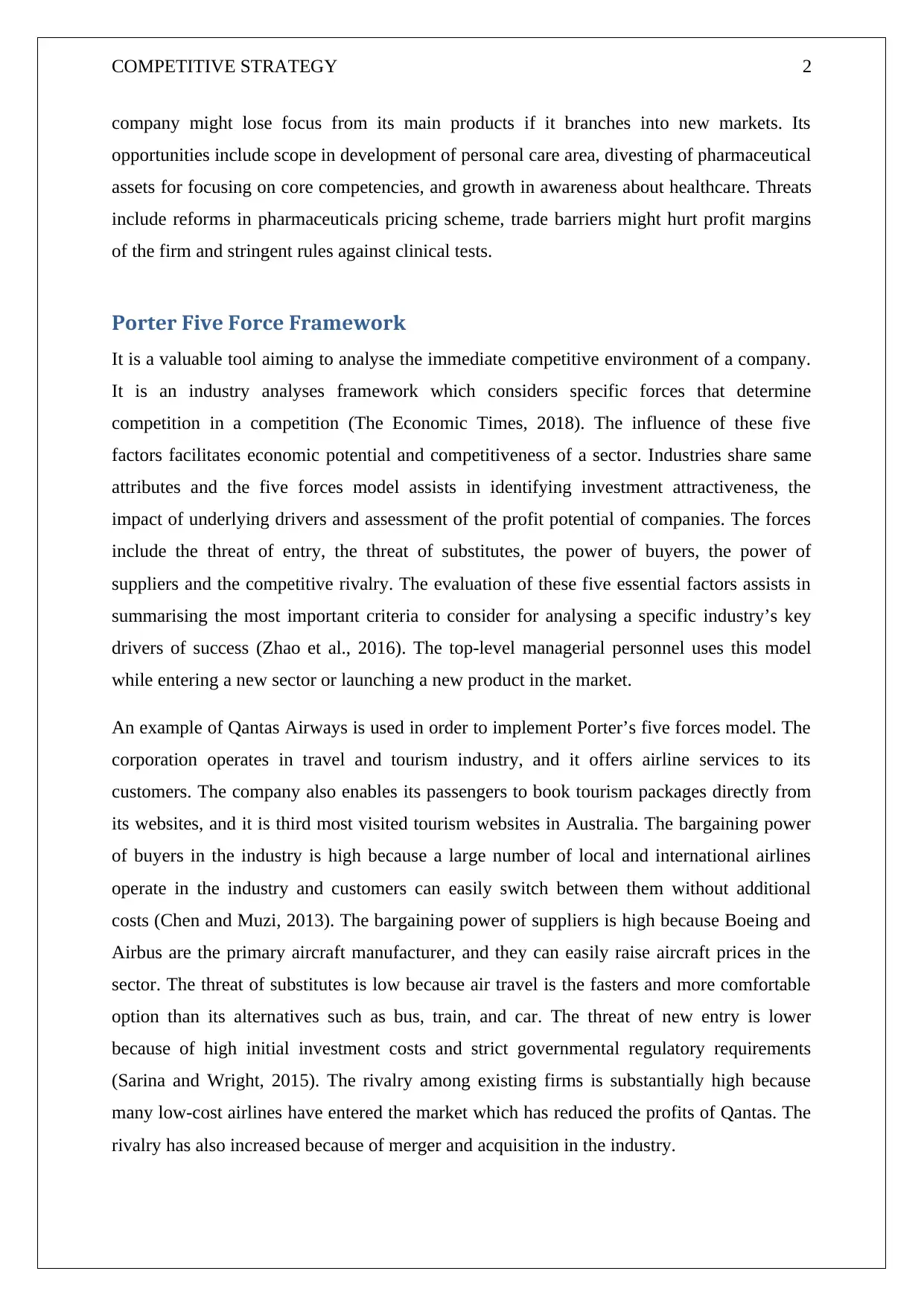
COMPETITIVE STRATEGY 2
company might lose focus from its main products if it branches into new markets. Its
opportunities include scope in development of personal care area, divesting of pharmaceutical
assets for focusing on core competencies, and growth in awareness about healthcare. Threats
include reforms in pharmaceuticals pricing scheme, trade barriers might hurt profit margins
of the firm and stringent rules against clinical tests.
Porter Five Force Framework
It is a valuable tool aiming to analyse the immediate competitive environment of a company.
It is an industry analyses framework which considers specific forces that determine
competition in a competition (The Economic Times, 2018). The influence of these five
factors facilitates economic potential and competitiveness of a sector. Industries share same
attributes and the five forces model assists in identifying investment attractiveness, the
impact of underlying drivers and assessment of the profit potential of companies. The forces
include the threat of entry, the threat of substitutes, the power of buyers, the power of
suppliers and the competitive rivalry. The evaluation of these five essential factors assists in
summarising the most important criteria to consider for analysing a specific industry’s key
drivers of success (Zhao et al., 2016). The top-level managerial personnel uses this model
while entering a new sector or launching a new product in the market.
An example of Qantas Airways is used in order to implement Porter’s five forces model. The
corporation operates in travel and tourism industry, and it offers airline services to its
customers. The company also enables its passengers to book tourism packages directly from
its websites, and it is third most visited tourism websites in Australia. The bargaining power
of buyers in the industry is high because a large number of local and international airlines
operate in the industry and customers can easily switch between them without additional
costs (Chen and Muzi, 2013). The bargaining power of suppliers is high because Boeing and
Airbus are the primary aircraft manufacturer, and they can easily raise aircraft prices in the
sector. The threat of substitutes is low because air travel is the fasters and more comfortable
option than its alternatives such as bus, train, and car. The threat of new entry is lower
because of high initial investment costs and strict governmental regulatory requirements
(Sarina and Wright, 2015). The rivalry among existing firms is substantially high because
many low-cost airlines have entered the market which has reduced the profits of Qantas. The
rivalry has also increased because of merger and acquisition in the industry.
company might lose focus from its main products if it branches into new markets. Its
opportunities include scope in development of personal care area, divesting of pharmaceutical
assets for focusing on core competencies, and growth in awareness about healthcare. Threats
include reforms in pharmaceuticals pricing scheme, trade barriers might hurt profit margins
of the firm and stringent rules against clinical tests.
Porter Five Force Framework
It is a valuable tool aiming to analyse the immediate competitive environment of a company.
It is an industry analyses framework which considers specific forces that determine
competition in a competition (The Economic Times, 2018). The influence of these five
factors facilitates economic potential and competitiveness of a sector. Industries share same
attributes and the five forces model assists in identifying investment attractiveness, the
impact of underlying drivers and assessment of the profit potential of companies. The forces
include the threat of entry, the threat of substitutes, the power of buyers, the power of
suppliers and the competitive rivalry. The evaluation of these five essential factors assists in
summarising the most important criteria to consider for analysing a specific industry’s key
drivers of success (Zhao et al., 2016). The top-level managerial personnel uses this model
while entering a new sector or launching a new product in the market.
An example of Qantas Airways is used in order to implement Porter’s five forces model. The
corporation operates in travel and tourism industry, and it offers airline services to its
customers. The company also enables its passengers to book tourism packages directly from
its websites, and it is third most visited tourism websites in Australia. The bargaining power
of buyers in the industry is high because a large number of local and international airlines
operate in the industry and customers can easily switch between them without additional
costs (Chen and Muzi, 2013). The bargaining power of suppliers is high because Boeing and
Airbus are the primary aircraft manufacturer, and they can easily raise aircraft prices in the
sector. The threat of substitutes is low because air travel is the fasters and more comfortable
option than its alternatives such as bus, train, and car. The threat of new entry is lower
because of high initial investment costs and strict governmental regulatory requirements
(Sarina and Wright, 2015). The rivalry among existing firms is substantially high because
many low-cost airlines have entered the market which has reduced the profits of Qantas. The
rivalry has also increased because of merger and acquisition in the industry.
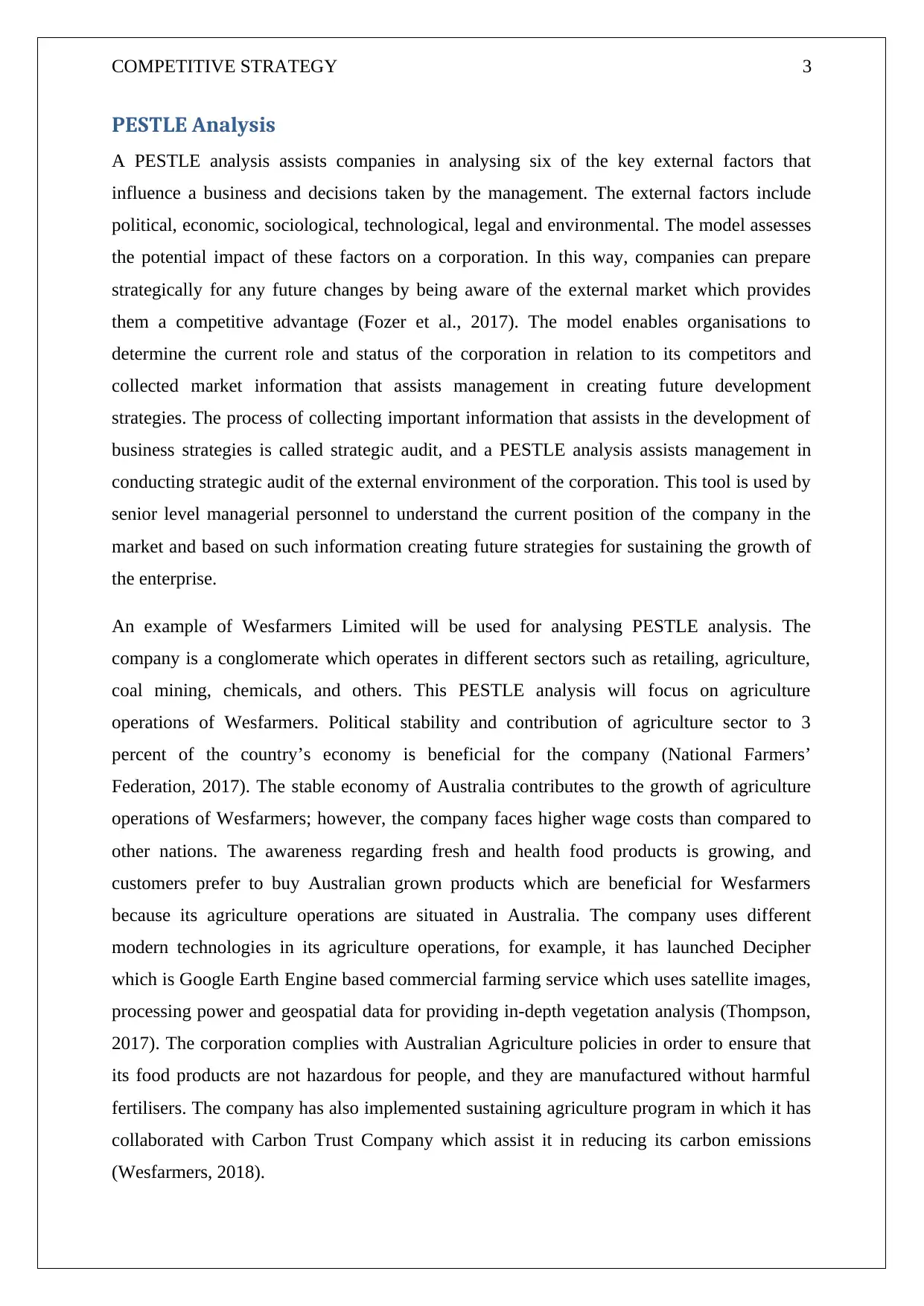
COMPETITIVE STRATEGY 3
PESTLE Analysis
A PESTLE analysis assists companies in analysing six of the key external factors that
influence a business and decisions taken by the management. The external factors include
political, economic, sociological, technological, legal and environmental. The model assesses
the potential impact of these factors on a corporation. In this way, companies can prepare
strategically for any future changes by being aware of the external market which provides
them a competitive advantage (Fozer et al., 2017). The model enables organisations to
determine the current role and status of the corporation in relation to its competitors and
collected market information that assists management in creating future development
strategies. The process of collecting important information that assists in the development of
business strategies is called strategic audit, and a PESTLE analysis assists management in
conducting strategic audit of the external environment of the corporation. This tool is used by
senior level managerial personnel to understand the current position of the company in the
market and based on such information creating future strategies for sustaining the growth of
the enterprise.
An example of Wesfarmers Limited will be used for analysing PESTLE analysis. The
company is a conglomerate which operates in different sectors such as retailing, agriculture,
coal mining, chemicals, and others. This PESTLE analysis will focus on agriculture
operations of Wesfarmers. Political stability and contribution of agriculture sector to 3
percent of the country’s economy is beneficial for the company (National Farmers’
Federation, 2017). The stable economy of Australia contributes to the growth of agriculture
operations of Wesfarmers; however, the company faces higher wage costs than compared to
other nations. The awareness regarding fresh and health food products is growing, and
customers prefer to buy Australian grown products which are beneficial for Wesfarmers
because its agriculture operations are situated in Australia. The company uses different
modern technologies in its agriculture operations, for example, it has launched Decipher
which is Google Earth Engine based commercial farming service which uses satellite images,
processing power and geospatial data for providing in-depth vegetation analysis (Thompson,
2017). The corporation complies with Australian Agriculture policies in order to ensure that
its food products are not hazardous for people, and they are manufactured without harmful
fertilisers. The company has also implemented sustaining agriculture program in which it has
collaborated with Carbon Trust Company which assist it in reducing its carbon emissions
(Wesfarmers, 2018).
PESTLE Analysis
A PESTLE analysis assists companies in analysing six of the key external factors that
influence a business and decisions taken by the management. The external factors include
political, economic, sociological, technological, legal and environmental. The model assesses
the potential impact of these factors on a corporation. In this way, companies can prepare
strategically for any future changes by being aware of the external market which provides
them a competitive advantage (Fozer et al., 2017). The model enables organisations to
determine the current role and status of the corporation in relation to its competitors and
collected market information that assists management in creating future development
strategies. The process of collecting important information that assists in the development of
business strategies is called strategic audit, and a PESTLE analysis assists management in
conducting strategic audit of the external environment of the corporation. This tool is used by
senior level managerial personnel to understand the current position of the company in the
market and based on such information creating future strategies for sustaining the growth of
the enterprise.
An example of Wesfarmers Limited will be used for analysing PESTLE analysis. The
company is a conglomerate which operates in different sectors such as retailing, agriculture,
coal mining, chemicals, and others. This PESTLE analysis will focus on agriculture
operations of Wesfarmers. Political stability and contribution of agriculture sector to 3
percent of the country’s economy is beneficial for the company (National Farmers’
Federation, 2017). The stable economy of Australia contributes to the growth of agriculture
operations of Wesfarmers; however, the company faces higher wage costs than compared to
other nations. The awareness regarding fresh and health food products is growing, and
customers prefer to buy Australian grown products which are beneficial for Wesfarmers
because its agriculture operations are situated in Australia. The company uses different
modern technologies in its agriculture operations, for example, it has launched Decipher
which is Google Earth Engine based commercial farming service which uses satellite images,
processing power and geospatial data for providing in-depth vegetation analysis (Thompson,
2017). The corporation complies with Australian Agriculture policies in order to ensure that
its food products are not hazardous for people, and they are manufactured without harmful
fertilisers. The company has also implemented sustaining agriculture program in which it has
collaborated with Carbon Trust Company which assist it in reducing its carbon emissions
(Wesfarmers, 2018).
Secure Best Marks with AI Grader
Need help grading? Try our AI Grader for instant feedback on your assignments.
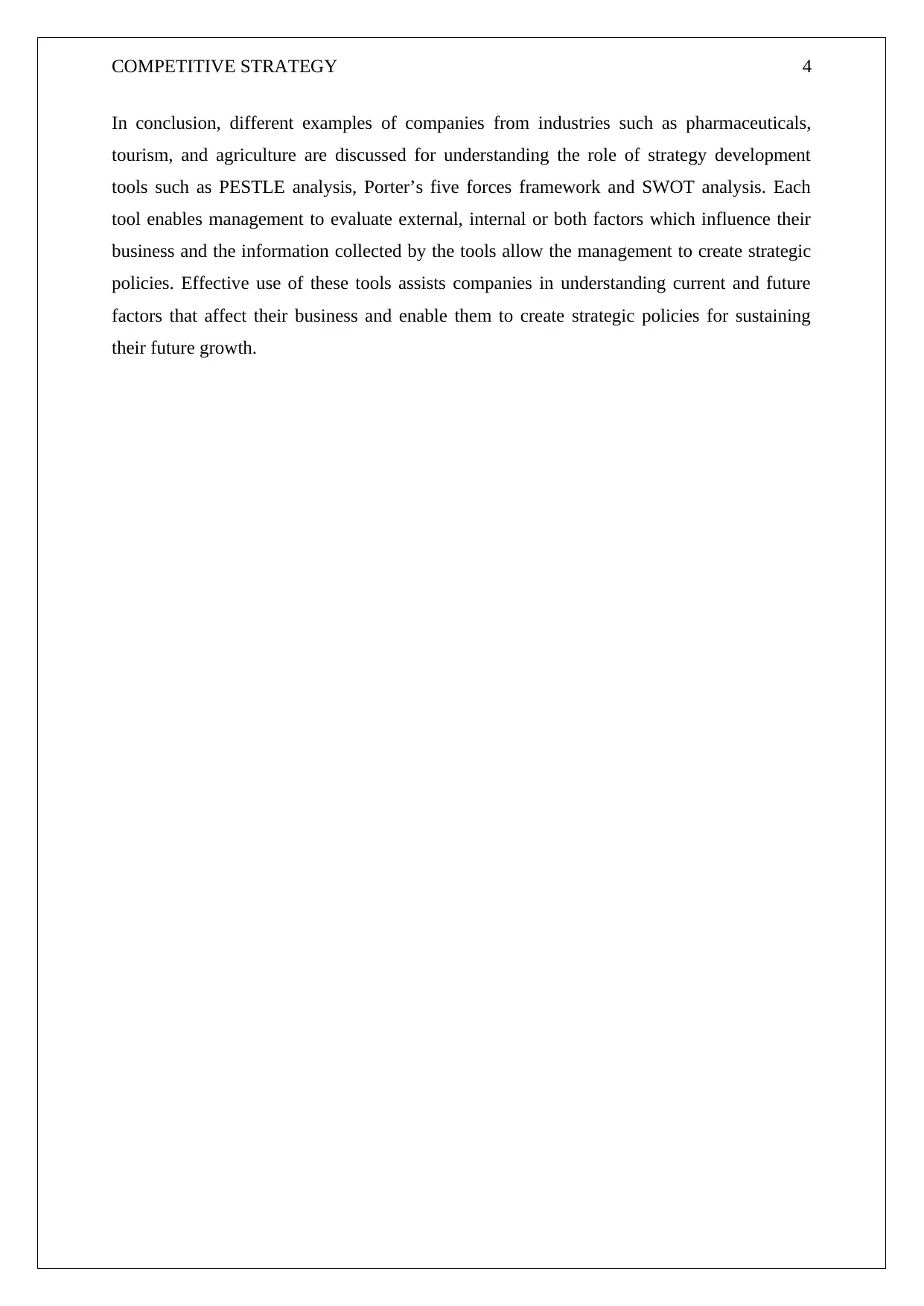
COMPETITIVE STRATEGY 4
In conclusion, different examples of companies from industries such as pharmaceuticals,
tourism, and agriculture are discussed for understanding the role of strategy development
tools such as PESTLE analysis, Porter’s five forces framework and SWOT analysis. Each
tool enables management to evaluate external, internal or both factors which influence their
business and the information collected by the tools allow the management to create strategic
policies. Effective use of these tools assists companies in understanding current and future
factors that affect their business and enable them to create strategic policies for sustaining
their future growth.
In conclusion, different examples of companies from industries such as pharmaceuticals,
tourism, and agriculture are discussed for understanding the role of strategy development
tools such as PESTLE analysis, Porter’s five forces framework and SWOT analysis. Each
tool enables management to evaluate external, internal or both factors which influence their
business and the information collected by the tools allow the management to create strategic
policies. Effective use of these tools assists companies in understanding current and future
factors that affect their business and enable them to create strategic policies for sustaining
their future growth.
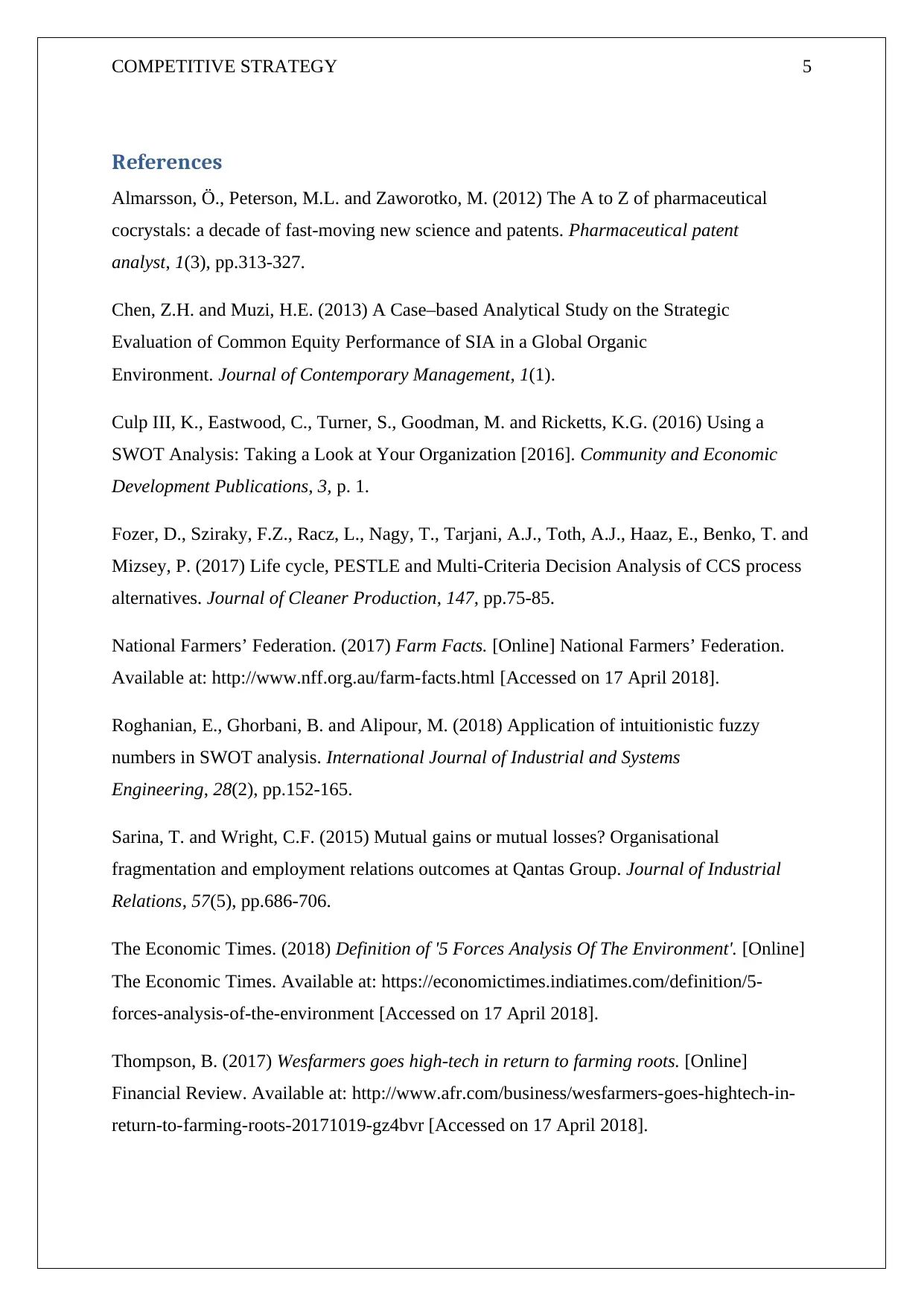
COMPETITIVE STRATEGY 5
References
Almarsson, Ö., Peterson, M.L. and Zaworotko, M. (2012) The A to Z of pharmaceutical
cocrystals: a decade of fast-moving new science and patents. Pharmaceutical patent
analyst, 1(3), pp.313-327.
Chen, Z.H. and Muzi, H.E. (2013) A Case–based Analytical Study on the Strategic
Evaluation of Common Equity Performance of SIA in a Global Organic
Environment. Journal of Contemporary Management, 1(1).
Culp III, K., Eastwood, C., Turner, S., Goodman, M. and Ricketts, K.G. (2016) Using a
SWOT Analysis: Taking a Look at Your Organization [2016]. Community and Economic
Development Publications, 3, p. 1.
Fozer, D., Sziraky, F.Z., Racz, L., Nagy, T., Tarjani, A.J., Toth, A.J., Haaz, E., Benko, T. and
Mizsey, P. (2017) Life cycle, PESTLE and Multi-Criteria Decision Analysis of CCS process
alternatives. Journal of Cleaner Production, 147, pp.75-85.
National Farmers’ Federation. (2017) Farm Facts. [Online] National Farmers’ Federation.
Available at: http://www.nff.org.au/farm-facts.html [Accessed on 17 April 2018].
Roghanian, E., Ghorbani, B. and Alipour, M. (2018) Application of intuitionistic fuzzy
numbers in SWOT analysis. International Journal of Industrial and Systems
Engineering, 28(2), pp.152-165.
Sarina, T. and Wright, C.F. (2015) Mutual gains or mutual losses? Organisational
fragmentation and employment relations outcomes at Qantas Group. Journal of Industrial
Relations, 57(5), pp.686-706.
The Economic Times. (2018) Definition of '5 Forces Analysis Of The Environment'. [Online]
The Economic Times. Available at: https://economictimes.indiatimes.com/definition/5-
forces-analysis-of-the-environment [Accessed on 17 April 2018].
Thompson, B. (2017) Wesfarmers goes high-tech in return to farming roots. [Online]
Financial Review. Available at: http://www.afr.com/business/wesfarmers-goes-hightech-in-
return-to-farming-roots-20171019-gz4bvr [Accessed on 17 April 2018].
References
Almarsson, Ö., Peterson, M.L. and Zaworotko, M. (2012) The A to Z of pharmaceutical
cocrystals: a decade of fast-moving new science and patents. Pharmaceutical patent
analyst, 1(3), pp.313-327.
Chen, Z.H. and Muzi, H.E. (2013) A Case–based Analytical Study on the Strategic
Evaluation of Common Equity Performance of SIA in a Global Organic
Environment. Journal of Contemporary Management, 1(1).
Culp III, K., Eastwood, C., Turner, S., Goodman, M. and Ricketts, K.G. (2016) Using a
SWOT Analysis: Taking a Look at Your Organization [2016]. Community and Economic
Development Publications, 3, p. 1.
Fozer, D., Sziraky, F.Z., Racz, L., Nagy, T., Tarjani, A.J., Toth, A.J., Haaz, E., Benko, T. and
Mizsey, P. (2017) Life cycle, PESTLE and Multi-Criteria Decision Analysis of CCS process
alternatives. Journal of Cleaner Production, 147, pp.75-85.
National Farmers’ Federation. (2017) Farm Facts. [Online] National Farmers’ Federation.
Available at: http://www.nff.org.au/farm-facts.html [Accessed on 17 April 2018].
Roghanian, E., Ghorbani, B. and Alipour, M. (2018) Application of intuitionistic fuzzy
numbers in SWOT analysis. International Journal of Industrial and Systems
Engineering, 28(2), pp.152-165.
Sarina, T. and Wright, C.F. (2015) Mutual gains or mutual losses? Organisational
fragmentation and employment relations outcomes at Qantas Group. Journal of Industrial
Relations, 57(5), pp.686-706.
The Economic Times. (2018) Definition of '5 Forces Analysis Of The Environment'. [Online]
The Economic Times. Available at: https://economictimes.indiatimes.com/definition/5-
forces-analysis-of-the-environment [Accessed on 17 April 2018].
Thompson, B. (2017) Wesfarmers goes high-tech in return to farming roots. [Online]
Financial Review. Available at: http://www.afr.com/business/wesfarmers-goes-hightech-in-
return-to-farming-roots-20171019-gz4bvr [Accessed on 17 April 2018].
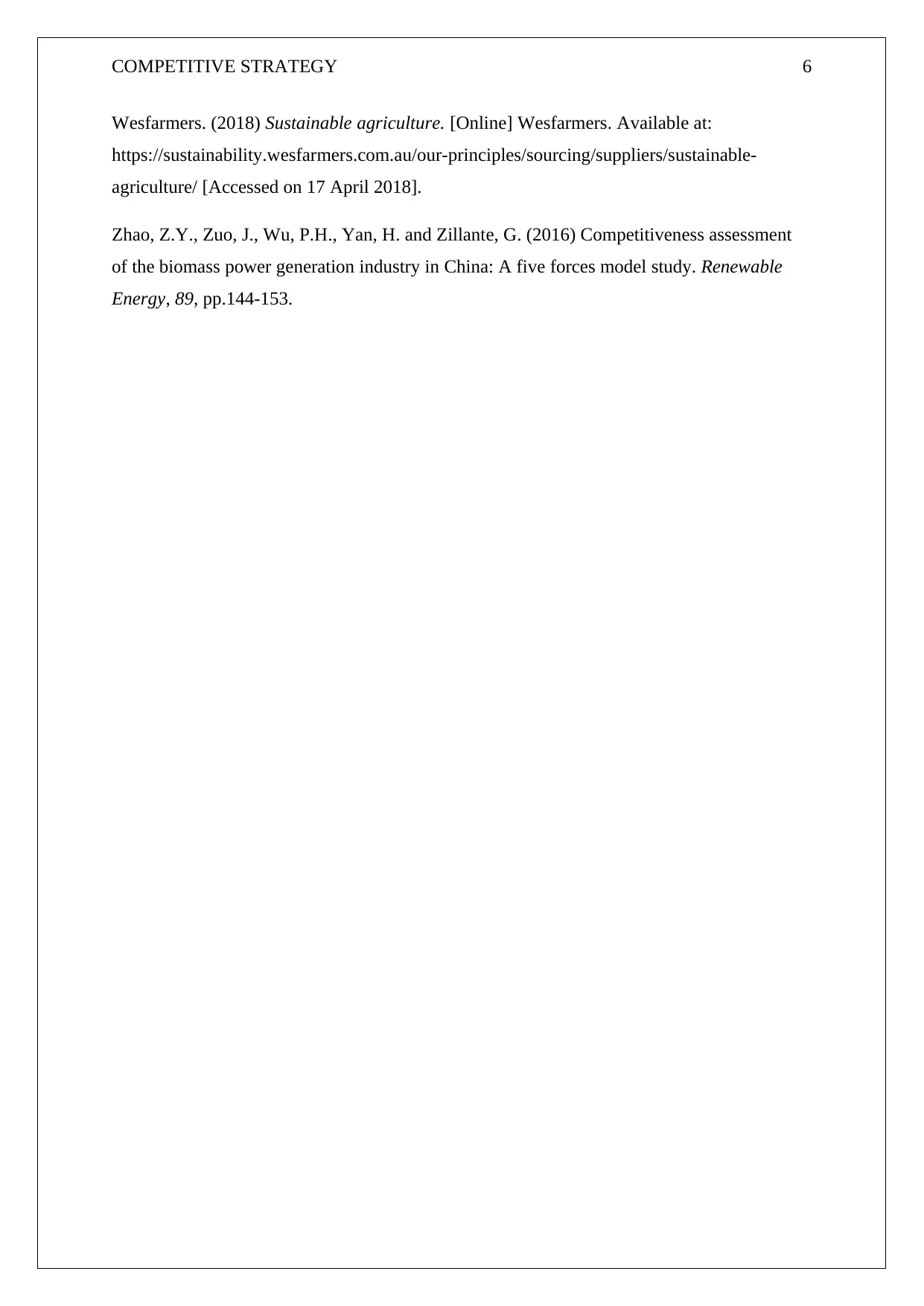
COMPETITIVE STRATEGY 6
Wesfarmers. (2018) Sustainable agriculture. [Online] Wesfarmers. Available at:
https://sustainability.wesfarmers.com.au/our-principles/sourcing/suppliers/sustainable-
agriculture/ [Accessed on 17 April 2018].
Zhao, Z.Y., Zuo, J., Wu, P.H., Yan, H. and Zillante, G. (2016) Competitiveness assessment
of the biomass power generation industry in China: A five forces model study. Renewable
Energy, 89, pp.144-153.
Wesfarmers. (2018) Sustainable agriculture. [Online] Wesfarmers. Available at:
https://sustainability.wesfarmers.com.au/our-principles/sourcing/suppliers/sustainable-
agriculture/ [Accessed on 17 April 2018].
Zhao, Z.Y., Zuo, J., Wu, P.H., Yan, H. and Zillante, G. (2016) Competitiveness assessment
of the biomass power generation industry in China: A five forces model study. Renewable
Energy, 89, pp.144-153.
1 out of 7
Related Documents
Your All-in-One AI-Powered Toolkit for Academic Success.
+13062052269
info@desklib.com
Available 24*7 on WhatsApp / Email
![[object Object]](/_next/static/media/star-bottom.7253800d.svg)
Unlock your academic potential
© 2024 | Zucol Services PVT LTD | All rights reserved.



